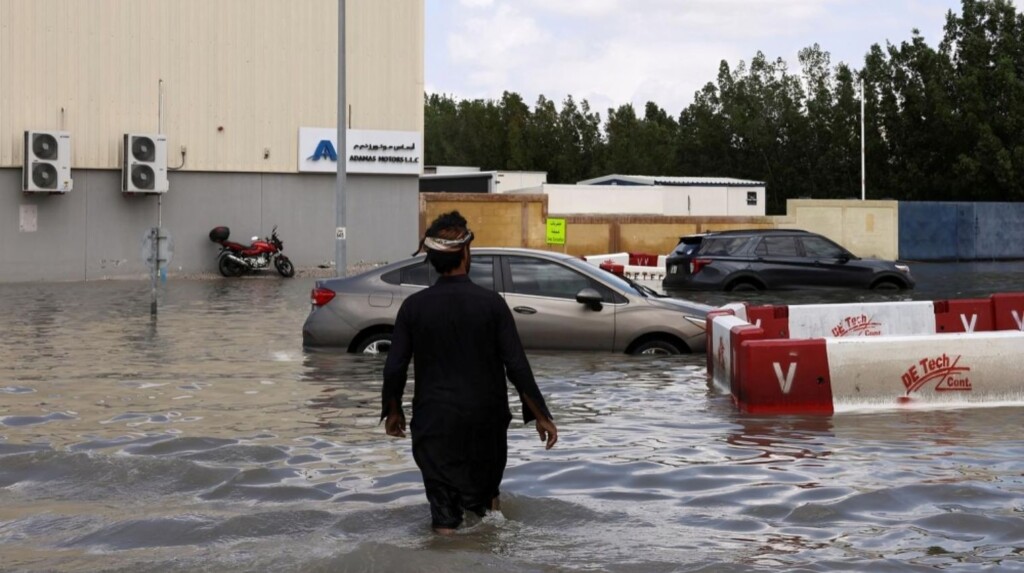Dubai, a desert city, experienced an unprecedented amount of rainfall, with 25 cm (10 inches) falling within just 24 hours. This quantity of rain is typically what the city receives in almost two years. The UAE’s National Center of Meteorology reported that this historic rainfall event is the first of its kind in the last 75 years.
The heavy rains led to flooding on major highways and caused disruptions in flights at Dubai International Airport. Homes were inundated, and vehicles were left stranded on the roads, prompting authorities to dispatch tanker trucks to pump out the excess water.
Social media images depicted flooded flagship shopping malls like Dubai Mall and Mall of the Emirates, along with ankle-deep water at Dubai Metro Station. Lightning strikes were also observed near the top of Burj Khalifa, the tallest building in the world.
What were the reasons behind the unprecedented rainfall in Dubai?
Experts have linked the rainwater to a large storm system moving across the Arabian Peninsula and the Gulf of Oman. This weather pattern is causing unusually wet conditions in Oman and southern-eastern Iran. Climate scientist Colin McCarthy attributes the heavy rains to intense thunderstorms forming over the warm waters of the Persian Gulf.
Some believe that climate change is responsible for the increased rainfall. Climatologist Friederike Otto stated that human-caused climate change likely intensified the rain in Oman and Dubai.
There are also suggestions that cloud seeding may have contributed to the heavy rainfall in Dubai. Meteorologist Jeff Berardelli pointed out that the storm carried a significant amount of dust, which can act as a cloud seeder. He questioned whether the man-made seeding or the natural dust particles were responsible for the heavy rains.
According to the journal Nature, future rainfall extremes are expected to increase with global warming. However, the impact on common and rare rainfall events may vary.
WHAT IS CLOUD SEEDING AND HOW IT ENHANCED RAINS IN DUBAI?
The UAE initiated cloud seeding operations in the 2000s to address water security concerns, despite the potential for flooding due to inadequate drainage in certain areas.
As reported by BNN Bloomberg, the National Center of Meteorology dispatched seeding planes from Al Ain airport on Monday and Tuesday to take advantage of convective cloud formations. This method involves introducing chemicals and small particles, often salt like potassium chloride, into the atmosphere to stimulate more rainfall from the clouds.
The seeding process entails releasing salt flares or other small materials into the clouds to generate additional rainfall. These flares, attached to the wings of the aircraft, contain salt components. Once they reach the targeted clouds, the flares are deployed, releasing the seeding agent into the cloud.
The salt particles act as nuclei around which water droplets condense, eventually becoming heavy enough to precipitate as rain.
According to the UAEREP’s description of the process, the National Center of Meteorology has established a network of 86 automatic weather stations (AWOS) for weather monitoring, six weather radars covering the entire UAE, and one upper air station. Additionally, the center has developed climate databases and contributed to the creation of high-precision Numerical Weather Predictions and simulation software in the UAE.
Minister of Climate Change and Environment, Mariam Al Mheiri, emphasizes that the nation’s rain enhancement initiative is crucial for improving food and water security, replenishing groundwater reserves, and promoting tourism.
The Gulf nation’s artificial rain initiative has been strengthened through collaborative scientific and technical research conducted with the National Center for Atmospheric Research (NCAR) in Colorado, USA, Witwatersrand University in South Africa, and NASA.
CLIMATE CHANGE IMPACT ON DUBAI
Sea Levels: The United Arab Emirates boasts a coastline stretching nearly 1,300 km, with a significant portion of the population and infrastructure situated within close proximity to the sea. A report from the Stockholm Environment Institute’s US Center has indicated that the UAE may face a loss of up to 6% of its developed coastline by the end of the century due to rising sea levels. Additionally, the UAE encountered severe coral bleaching and mortality events in 1996 and 1998, linked to anomalies in seawater temperatures.
Water Disasters: The phenomenon of global warming has the potential to widen the gap between water demand and supply. Some regions in the UAE are likely to witness increased instances of flooding, while others may suffer from droughts and water scarcity.
Agriculture: Rising temperatures, along with the proliferation of weeds and harmful insects, are expected to have adverse effects on agricultural produce. The implications of global warming could lead to food shortages on a global scale. The UAE may face challenges related to saline water intrusion, making it difficult to procure local food supplies.
Pollution and Power Supply: The impact of global warming is anticipated to reduce the necessity for heaters during winter months, while simultaneously increasing the demand for air conditioning in the summer. Furthermore, there is a risk of heightened pollution levels as a result of global warming. The UAE currently has a per capita carbon dioxide emission of 80 tonnes, significantly higher than the 14 tonnes per capita in the United States. The country heavily relies on air conditioners, desalination plants, and power stations that operate on carbon-based fuels, which can pose health risks to humans at certain levels.
